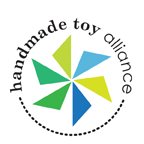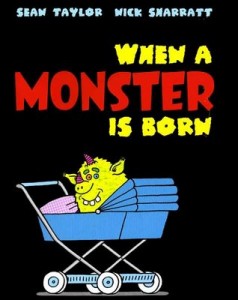 Carol Baicker-McKee is stunned to find that line appearing as part of a slide presentation for staff of the Consumer Product Safety Commission (CPSC) on enforcement of CPSIA (for those just catching up, CPSC’s guidelines last month recommend that resellers discard pre-1985 kids’ books unless the books are put through expensive testing.) It has her “ready to move to Australia. Or, better yet, ready to make Congress move to Australia and let the country start fresh.” Read the whole thing. More: Esther at Reader’s Loft.
Carol Baicker-McKee is stunned to find that line appearing as part of a slide presentation for staff of the Consumer Product Safety Commission (CPSC) on enforcement of CPSIA (for those just catching up, CPSC’s guidelines last month recommend that resellers discard pre-1985 kids’ books unless the books are put through expensive testing.) It has her “ready to move to Australia. Or, better yet, ready to make Congress move to Australia and let the country start fresh.” Read the whole thing. More: Esther at Reader’s Loft.
Posts Tagged ‘CPSIA and books’
CPSIA: “What’s so sad is that books aren’t dangerous”
Excellent article today on libraries, books and CPSIA in one of Texas’s leading newspapers, the Fort Worth Star-Telegram. 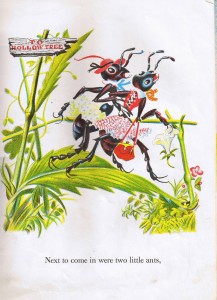 It confirms, among other things, that the big Half Price Books chain has made a policy of pulling pre-1985 books from its shelves, as well as more recent books that contain various kinds of embellishments and special features. If you happen to know an editor with the New York Times, the Chicago Tribune or one of the other big media outlets that are still utterly ignoring the crisis, this makes a good clip to send them, just to let them know that 1) what’s going on is only too real; and 2) they’re being scooped repeatedly by other journalists, just as the Boston Globe scooped them last week on the resale story.
It confirms, among other things, that the big Half Price Books chain has made a policy of pulling pre-1985 books from its shelves, as well as more recent books that contain various kinds of embellishments and special features. If you happen to know an editor with the New York Times, the Chicago Tribune or one of the other big media outlets that are still utterly ignoring the crisis, this makes a good clip to send them, just to let them know that 1) what’s going on is only too real; and 2) they’re being scooped repeatedly by other journalists, just as the Boston Globe scooped them last week on the resale story.
Also on the library issue, there is good coverage in the Zanesville, Ohio Times Reporter (a disproportionate amount of the good library coverage has come from the state of Ohio, which I suspect must be a tribute to some energetic library people there). The American Library Association has a wiki reiterating (at present) that association’s advice to members not to throw out pre-1985 books: “If you feel you must remove books from circulation, please store them until rulings are clearer!”. In her latest roundup, Deputy Headmistress describes how her own local library is boxing up many books that are likely to have been printed after 1985, because their copyright date falls before then; it is a common practice for children’s books to list only a copyright date even if they were printed many years later. So at that cautious library, at least, the law’s effects are even more drastic than one might have assumed.
Darwin Central, which took out after the offending Snopes.com on the books issue a couple of weeks ago, follows up today with a post entitled, “Snopes Defending the Book Burners”.  Linda L. Richards at January Magazine was among those misled by the Snopes slant. In a wide-ranging CPSIA roundup last month (worth reading in its entirety), Punditry by the Pint had wise advice: “This might be one of the cases where it would be good to read up on Snopes’ False Authority Syndrome page.” A visit to the Snopes page in question indicates that it now carries a “Last Updated” date of February 19, which indicates that it has been changed since we last had occasion to discuss it; at a brief glance, some of the dismissive language I and others found so objectionable seems no longer to be there, though it has not been replaced by language that’s actually cogent or up-to-date. Someone might want to do a before-and-after comparison using the Wayback Machine.
Linda L. Richards at January Magazine was among those misled by the Snopes slant. In a wide-ranging CPSIA roundup last month (worth reading in its entirety), Punditry by the Pint had wise advice: “This might be one of the cases where it would be good to read up on Snopes’ False Authority Syndrome page.” A visit to the Snopes page in question indicates that it now carries a “Last Updated” date of February 19, which indicates that it has been changed since we last had occasion to discuss it; at a brief glance, some of the dismissive language I and others found so objectionable seems no longer to be there, though it has not been replaced by language that’s actually cogent or up-to-date. Someone might want to do a before-and-after comparison using the Wayback Machine.
Also on books, children’s book author and editor Carol Baicker-McKee has a lovely followup to her excellent post of a day earlier, describing some of the kinds of older children’s books (of uncertain copyright status, too “quiet” in their themes to attract reprint interest from publishers) that might face a bleak future. She admires silhouette art, a feature of many midcentury children’s books (like the 1941 Marcella Chute volume from which this illustration is taken) but which is uncommon today.

Baicker-McKee has devoted more thought to the economics of children’s publishing than have most of us, and she writes beautifully of what is at risk. Ed Driscoll also has some to-the-point observations at Pajamas Media, where he quotes Mark Steyn: “A nation’s collective memory is the unseen seven-eighths of the iceberg. When you sever that, what’s left just bobs around on the surface, unmoored in every sense.”
There are other news stories I haven’t gotten to — in particular, the Wall Street Journal’s important reporting on $1 billion-plus (at least) in stranded inventories, much of which may be headed for landfills, and the news of the sudden 40% drop in the stock price of well-known kids’ retailer Gymboree as it was forced to take massive inventory write-offs. I’ll have to get to those at a later date, however, as an unrelated deadline is going to be absorbing much of my attention over the next few days.
CPSIA chronicles, March 3
- There’s new blogging on the fate of pre-1985 children’s books from book restorer and conservator Javamom, Jane Badger (iBookNet, U.K.), Dillon Hillas, Wellspring Creations, and Small-Leaved Shamrock.
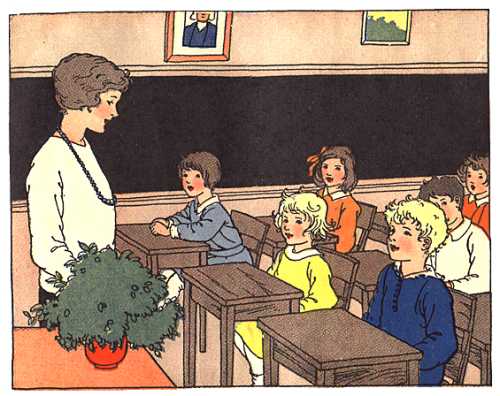 Deputy Headmistress continues to blog the book angle intensively, as does Valerie Jacobsen (read this post in particular). Note also the comment from Nancy Welliver on her February 11 post: “We are a used curriculum and book seller. We have removed 3,500 books from our website. … until recently publishers did not put printing dates in books, only copyright dates. So a book that is copyrighted 1976 may have been printed in 1988 and therefore legal to sell, So how do we know which are printed before and which after 1985? So we have removed all books for children with copyright date 1985 and before.” There’s also a page at cpsia-central (the Ning group) on books and libraries.
Deputy Headmistress continues to blog the book angle intensively, as does Valerie Jacobsen (read this post in particular). Note also the comment from Nancy Welliver on her February 11 post: “We are a used curriculum and book seller. We have removed 3,500 books from our website. … until recently publishers did not put printing dates in books, only copyright dates. So a book that is copyrighted 1976 may have been printed in 1988 and therefore legal to sell, So how do we know which are printed before and which after 1985? So we have removed all books for children with copyright date 1985 and before.” There’s also a page at cpsia-central (the Ning group) on books and libraries. - The law is also having a major impact on sellers of new children’s books, given that the only newer books presumed safe for legal purposes without testing are completely plain books with no embellishments or non-paper features. Don’t miss the letter at Wellspring Creations from “Jackie”, who identifies herself as the manager of the children’s book section at a Half Price Books store, part of a large chain that sells publisher’s remainders and overstocks as well as used books:
I have experienced the severity of this issue first-hand. … Initially, it didn’t seem like this would have much of an impact on the kids section, but as I went through my section pulling everything that was potentially harmful, I soon realized that this was going to decimate my section. My display tables were over halfway empty, and there were half-empty or completely empty shelves all throughout the section. … The kids cooking shelf went from being packed full to only having half a dozen books left, all because most of the cookbooks were spiral-bound with metal. …
The day that I had to get rid of all those books was one of the roughest days I’ve ever had at work. The kids section is my pride and joy, my baby, and I had to not only watch it get torn apart- I had to do it myself. It was heartbreaking.
The happy ending, if you want to call it that, is that eventually many or most of the new books are likely to return to the shelves after the chain puts them through testing — though it’s more likely to take such a step for a mass-selling branded item piled high on display tables than for a specialty cookbook expected to sell only in the dozens of copies. Go read the whole thing.
- Community Homestead is a center for developmentally disabled adults in rural Wisconsin that has sold residents’ handcraft toys. Its CPSIA story is here.
- Dust-ups in comments sections are not my thing, but some people enjoy them, and they keep breaking out on the occasions when someone still attempts an aggressive defense of this bad law. Thus when the Chicago Daily Herald printed a letter from Alexandra Lozanoff of the Illinois Public Interest Research Group (PIRG) yesterday rhapsodizing about the law, numerous commenters jumped in to express rather sharp disagreement. A state legislator in Orangeburg, South Carolina put her name to a piece in the local paper attacking Sen. Jim DeMint for sponsoring CPSIA reform, provoking dozens of comments, most taking issue. The Natural Resources Defense Council, which is invested in defending CPSIA in part because of the law’s phthalates ban, ran an ill-informed piece pretentiously titled “The Artisan Toymaker’s CPSIA Exemption Guide” and was promptly spanked by knowledgeable commenters, a fate that also befell the left-leaning crew at Moms Rising. The lengthy comments section on John Holbo’s thoughtful followup post at Crooked Timber presented the spectacle of one agitated and flailing defender of the law pretty much surrounded by people trying to talk sense into him. Someone adopting the monicker “Civil Justice” wandered into the Etsy forums to push Lawsuit Lobby views and was not met with pleasure by the assembled crafters, an episode which may be related to the one already told about how the misnamed Center for Justice and Democracy, a group with views antipodal to our own, suggested that we all were insensitive to children’s health and then refused to let any letters from critics through moderation, claiming to feel threatened by the letters’ tone (examples of the sorts of letter CJD found too intimidating in tone to run: Mark Riffey, Olivia @ BabyCandyStore). Some other previously linked comments discussions: The Pump Handle (profoundly misguided contributor corrected by Deputy Headmistress, Kathleen Fasanella, etc.), Consumer Reports, Greco Woodcrafting (Public Citizen’s David Arkush vs. the world), and, of course, Justinian Lane.
- Even a casual acquaintance with CPSIA blogging is enough to show that homeschooling parents have taken an extraordinary role in leading the resistance to the law. Bloggers like CalifMom have predicted that the law will have numerous harmful impacts on homeschoolers, and homeschool curriculum suppliers such as Hands and Hearts History Discovery Kits and Hope Chest Legacy have already closed down because of the impracticability of compliance. So it’s unfortunate that the Home School Legal Defense Association (HSLDA) seems to have so little clue what’s going on.
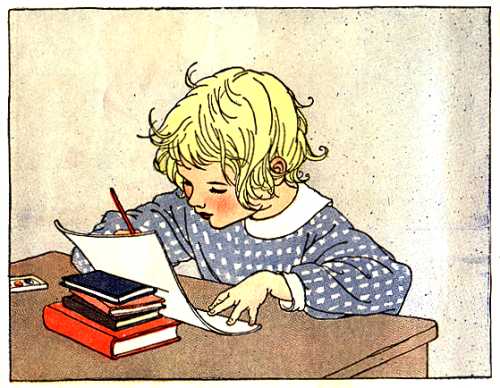
CPSIA chronicles, February 26

- UPDATE 5:45 p.m. Eastern: Well, that was quick. A source reports that Congressional staffers hastily announced that they’re canceling the hearing next week and that the idea is “not likely to ever be brought back”. Someone must have realized that letting people from around the country get in front of a microphone and talk about the effects of this law would not exactly do wonders for the image of Henry Waxman, Public Citizen, PIRG, or Consumer Federation of America. More: Rick Woldenberg confirms cancellation/disinvitation.
- A prime objective for critics of the Consumer Product Safety Improvement Act in recent weeks has been to obtain a hearing on Capitol Hill that might focus lawmaker and press attention on the law’s many unexpected and harmful effects. Now it looks as if that might be happening. Rick Woldenberg:
I have been invited to testify before the Subcommittee on Regulations and Healthcare of the House Committee on Small Business next Thursday. The purpose of this hearing is to explore Small Business issues related to the CPSIA. The Subcommittee is still looking for small businesses to testify. … If you are motivated to testify, you may want to reach out to the Subcommittee staff to volunteer, or if you have a Congressman on the Subcommittee, contact their Washington office urgently. …
- Relatedly, Whimsical Walney, whose time seems to have been in part freed up for blogging by the CPSIA-induced shutdown of her Bay-Area-based children’s line, offers some advice here and here on how to talk with lawmakers about the act.
- If you still haven’t taken a look at it, Daniel Kalder’s excellent BooksBlog entry in The Guardian (U.K.) on CPSIA and older books, which quotes from my City Journal article, is here. It’s drawn attention around the world, including places like France, Italy, and Romania.
- Speaking of books, America’s libraries appear to have dodged catastrophe for now with the help of the American Library Association’s (understandable under the circs) last-minute embrace of the position that unless someone announces otherwise, it’s going to assume the law doesn’t apply to library stacks or circulation (earlier; commentary on the shift, Deputy Headmistress and Rick Woldenberg). Thus: Cincinnati Enquirer (“We’re hopeful saner heads will prevail and they’ll exempt us,” says Emily Sheketoff of the ALA), Middletown (Ohio) Journal, Brown County, Ohio, News-Democrat.
So it seems to be mostly the librarians who are the most literal-minded and obedient about following guidance from high government authorities, or who are most legally risk-averse, or something, who are taking drastic steps like tarping over their pre-1985 stacks or planning to discard the volumes entirely or excluding older kids’ books from their used-book sales (in which case they’ll wind up….where?). Esther at Reading Loft/Design Loft has been picturing how libraries will look if they can’t make an exemption stick. And I didn’t notice it when it ran last month, but Annoyed Librarian had a funny rant at Library Journal about the law. Perish the thought, of course, that any library might ever want to acquire a pre-1985 book for kids’ use. - Popular conservative talk host Hugh Hewitt has continued his coverage of the law. Per one transcript, he discussed it with star columnist Mark Steyn who knew about the youth motorsports debacle:
In my little corner of New Hampshire, every 12-year old boy loves taking an ATV, loves riding it around up in the hills. And the idea that the lead in it is going to cause that kid to keel over, is preposterous. This is government by insanity…
On the other hand, Mark Riffey passes along word that popular talker Glenn Beck doesn’t plan to cover the issue because “there’s no public outcry” (a paraphrase second-hand of what might be a staffer’s view, or his, it’s not clear). What? Does he restrict his reading diet to the New York Times?
- Wacky Hermit at Organic Baby Farm is angry: “When you have to consult a lawyer before you hold a church benefit sale, you are not in America.” (some rude language).
- In the first-linked item above, Woldenberg also reports on an announcement by the Consumer Product Safety Commission’s chief of enforcement, Gib Mullan, that the commission intends to shift its enforcement methods in a more punitive direction, handing out many more penalties than previously in order to achieve more deterrent effects on businesses of all sizes. This is well in line with the clear guidance the commission has been given by Henry Waxman and colleagues in Congress. Next Thursday, if those planning the hearing do their jobs right, many in Congress might for the first time hear some voices that no one thought to consult when the law hurtled toward passage last summer. [REPEATING THE UPDATE: Hearing reportedly canceled.]
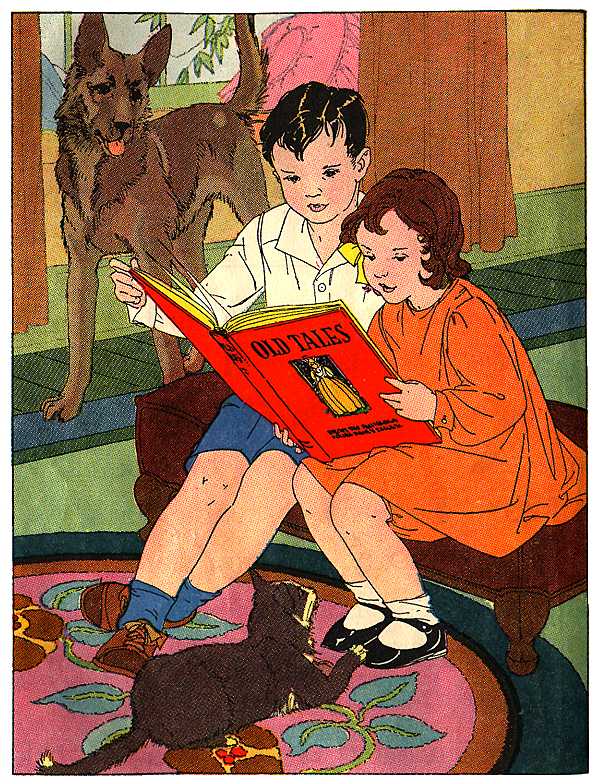
Public domain images: Grandma’s Graphics, Mabel Betsy Hill and Elson’s Basic Readers.
CPSIA chronicles, February 24
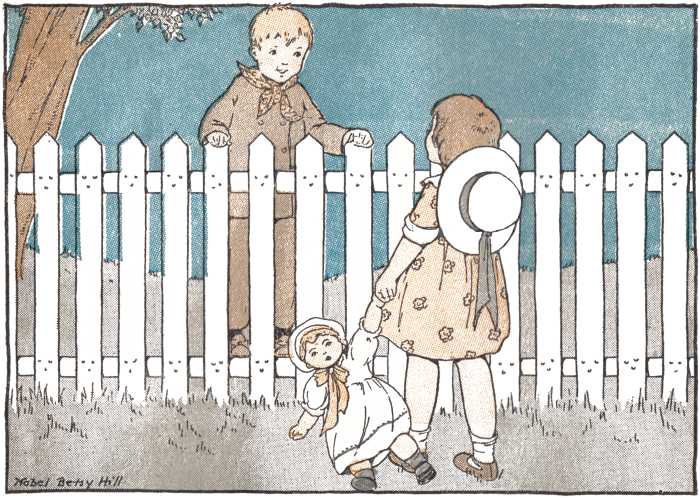
- More thrift store and reseller reports, not linked earlier: Blacksburg, Va. (“a lot of customer complaints at the YMCA at Virginia Tech since the thrift shop pulled kids’ toys off its shelves”), Chapel Hill/Carrboro, N.C. (“many patrons are upset” at absence of children’s items), Sioux City, Iowa (“To be on the safe side, Goodwill removed from the sales floors nearly all its used children’s clothing and all its toys”), Le Mars, Iowa (youngster’s outing ends in tears; items in storage for now).
And yet at many other stores — in other states or cities, maybe even down the block in the same town — decisions on what to drop have been much more selective. Thus New Orleans (large thrift store in St. Charles Parish “no longer accepting small toys, painted wood items or clothing with trinkets or toys attached to them,” those being, of course, a small fraction of the items that could lead to an inadvertent CPSIA violation), and Lufkin, Texas (list of goods Goodwill won’t accept includes bunk beds, bicycle helmets, embellished books, and many others, but a good bit narrower than CPSC guidance would suggest). The shop I visit most often, in a relatively prosperous NYC suburb, had a sparser-looking-than-usual selection yesterday, which nonetheless included items that would raise a definite eyebrow under the CPSC guidelines, such as kids’ athletic shoes with metal lacing grommets. And it’s not hard to find thrift outlets with relatively high profiles in their community — I won’t name names for fear of getting them into trouble — that don’t seem to have dropped much of anything. You’d hardly imagine that CPSIA was supposed to be a uniform national law. - Related: Riverside, Calif. Press-Enterprise, “Goodwill Industries International said it could potentially lose $134 million nationwide in the coming year if forced to dispose of all children’s clothing and products, according to spokeswoman Lauren Lawson.” And the Naperville, Ill., Sun covered the headaches of maternity and children’s reseller Connie Ballas (From My Room).
- Hugh Hewitt’s popular conservative radio show devoted an hour to the law yesterday, interviewing attorney Gary Wolensky of Snell & Wilmer, who represents manufacturers and whose discussion primarily focused on the headaches they face. The show drew a strong call-in reaction and has already led to a flurry of online interest in CPSIA reform.
- Meanwhile, Jennifer Grinnell of Sherborn, Mass. writes that CPSIA reform needs to be approached as more than a right-vs.-left, blue-red, Dem-Rep political football [Change.org]
- When the New Orleans Times-Picayune interviewed local toy stores, the independent retailer was finding the law “burdensome” and “very cumbersome” as she tried to communicate with all the producers of items in her stock, while the franchise operator seemed to be having a much easier time of it because he carried only items on a checklist from national and could piggyback his compliance paperwork on headquarters’. Yes, that sounds about right.
- Don’t toss those pre-’85 kids’ books, thrifters! Set them aside and await orders from D.C.! That seems to be the advice of Examiner columnist (and former children’s bookseller) Diane Petryk Bloom, who’s confident that a law this bad will be amended and suggests that in the mean time some civil disobedience might be in order, advice that might not be taken readily by resellers staring down the business end of those $100,000 potential fines.
Let’s assume she’s right that most people in the thrift store business can’t bring themselves to leave perfectly good children’s books out on the curb, and instead tuck them into storage for the time being or look the other way while an employee “borrows” them for home use. What happens next, as the weeks turn into months (or perhaps years) with no action from Henry Waxman & co.? The main mechanism by which we will lose older books is not so much that thrift stores will toss them in the trash, as that they’ll refuse to accept them as donations or consignments in the first place, while other outlets worried about legal liability (such as online auction sites) adopt similar policies. Once there’s no convenient way to dispose of the books even as donations, families will simply discard most of them (with occasional collectible/rarity exceptions) when the kids grow up, when moving house, or when winding up a family estate. It’s not as if there’s likely to be much press coverage of these micro-events, which doesn’t make them less than real.ParentDish and Etsy also have active threads in progress on the issue of older children’s books.
- Some other blog talk: Blue Rose Girls, Kora in Hell/WordSmoker (rude language), Lex Fortis (satire), and of course leading CPSIA-watchers Deputy Headmistress/Common Room (on press coverage, Consumers’ Union and dragons) and Valerie Jacobsen (what? you mean CPSC would target small business with punitive actions?)
- Sorry, even if your little girl has been saving up her allowance for one of our pretty hair barrettes, we can’t sell it to you, unless you want it for her dog [MaidenUS]

Public domain image: Grandma’s Graphics, Mabel Betsy Hill; dog image from MaidenUS.
CPSIA and print-on-demand

Print-on-demand technology has many promising applications for children’s products: it can keep low-sales-volume children’s books from falling out of print, for example, and it can make available T-shirts, posters or school supplies customized with the name of a particular child or family or that of a particular teacher’s class. Unfortunately, in the absence of a green light for component testing, each tiny “run” of goods may need to be lab-tested separately at what will often be prohibitive expense. The CPSC’s enforcement stay as to new-item testing bought a year’s time for most product makers, and its narrow and hastily granted exemption for newly printed books (which, alas, did not extend to countless other printed products) may have saved that particular product category.  For many other users and potential users of the technology, however, the problem has merely been kicked forward to next year in the absence of any willingness by Congress to clarify or change the law. Some discussions: Will Benton; Adam Dewitz, Print CEO (via Book Journeys), WSJ forums (dilemma faced by Tennessee printer). More on book exemption: AAP request, PDF; Etsy thread.
For many other users and potential users of the technology, however, the problem has merely been kicked forward to next year in the absence of any willingness by Congress to clarify or change the law. Some discussions: Will Benton; Adam Dewitz, Print CEO (via Book Journeys), WSJ forums (dilemma faced by Tennessee printer). More on book exemption: AAP request, PDF; Etsy thread.
CPSIA: Library books under an orange tarp
It’s happening at the Morton James Public Library in Nebraska City, Neb.:
A federal child product safety law has staff at the Morton James Public Library quarantining books behind bright orange plastic and wondering how many must be pulled forever from the shelves. …
Over 1,000 books with 1985 or older on the copyright page have already been quarantined behind an orange curtain.
Library Director Barbara Hegr said librarians will try to determine if the edition is a printing after the copyright date, so the book may be preserved.
Click through to the news story at the Nebraska City News-Press for more details, as well as a photo you may not soon forget. You can also Digg the story here.
CPSIA: Importing older children’s books
You didn’t think they were going to make it that easy, did you?
On February 10, 2009 we have added a Shipping Restriction for our Childrens Books, as follows: Effective February 10, 2009 Children’s Books will no longer be shipped to the USA. This change is being made because of the United States Consumer Product Safety Act (CPSIA). … We have added “SHIPPING NOT AVAILABLE TO THE USA” to the description of the books affected by this shipping restriction.
— announcement at Canada-based online used-book seller Trylinski Books.
Relatedly, on the domestic front: “The fun is over” says online vintage seller “Scribbler”, who’s pulling her stock of pre-1985 kids’ books, and yet feels optimistic: “I have to think the government will do the right thing over the next few months and alter this crazy law to make vintage kids’ books legal again, so I don’t expect to be out of business too too long.” (She’s also giving away to a random post-commenter a post-’85 reprint of a book by one of my favorite children’s illustrators, Wanda Gag.) Occasional eBay/Craigslist reseller jensyw tries to puzzle out the law’s requirements. More: Freddie DeBoer/League of Ordinary Gentlemen (“such a terrible, horrible, no good, very bad law”), Buried Treasure, Allison Kasic/Independent Women’s Forum. And @swonderful, on Twitter: “At consignment store they were disposing of pre-1985 books. The employee remarked how she will throw out all old books at home too.” After all, who knows better than the government?
More: Great coverage by Daniel Kalder in the Guardian (U.K.) Books Blog.

CPSIA chronicles, February 19
- Apparently I’m not the only one to lose patience with the New York Times, at least when they publish an editorial as bad as yesterday’s. My critique was not only (as mentioned) reprinted almost immediately at Forbes.com, but drew an extraordinary reaction elsewhere, including (not exhaustive): Virginia Postrel, Christopher Fountain, Patrick @ Popehat (strong language — now you’re sure to click), Carter Wood/ShopFloor, Mike Cernovich, Katherine Mangu-Ward/Reason “Hit and Run” (says I go “completely ballistic (in a good way!)”), Jonathan Adler @ Volokh Conspiracy, Memeorandum, Above the Law, Tim Sandefur, Mark Thompson/Donklephant (extensively “fisking” the Times editorial; related, Deputy Headmistress), Alison Morris/Publisher’s Weekly Shelftalker blog (law reminds her of Cory Doctorow novel Little Brother), Jacob Grier, Amy Alkon/Advice Goddess, Joe Weisenthal/ClusterStock, Valerie Jacobsen/Bookroom Blog. And: Deputy Headmistress at Common Room, Faith in Truth, Amy Ridenour/National Center and NewsBusters, Charles Kuffler/Off the Kuff. I’m particularly grateful to Robert Ambrogi at Legal Blog Watch for his wider look at how blogs and other newer media have helped correct the shortcomings of some venerable old-media institutions on this story.
- It’s often noted that the most visible economic interests on the children’s-products scene, namely the two big import-oriented toymakers, the makers of mass-market children’s apparel, disposable diapers, and the like, and the big retailers like Wal-Mart and Toys-R-Us, 1) mounted no effective resistance to CPSIA’s passage, 2) have experienced lobbyists in Washington who took an interest in the bill’s progress, and 3) can more or less live with the new rules as part of a business plan that includes mass factory runs and mass merchandising over which the high costs of testing and compliance can be spread, an advantage not shared by smaller producers and retailers. From this it is often concluded that the large companies purposely devised the law’s provisions so as to destroy smaller competitors. I doubt we’ll ever get a definitive answer to that question one way or the other unless Washington insiders step forward with firsthand accounts (hint), but I’d be wary of adopting the “Mattel and Hasbro are secretly chuckling all the way to the bank” meme without better evidence than has surfaced to date, for reasons outlined by David Foster, Kathleen Fasanella, and Deputy Headmistress. The last-named points quite reasonably to the long paper trail in which the Ralph-Nader-founded Public Citizen, a longstanding anti-business pressure group with close ties to the plaintiff’s bar, and its Nader-founded close ally PIRG, boast of having led the campaign for a maximally stringent CPSIA. Related points here (Eric Husman) and here and here (Deputy Headmistress). More: Mark Thompson has some highly pertinent things to add in the comments section.
- We’ve already visited the question whether one big organization that has vociferously defended CPSIA, the Natural Resources Defense Council, took care to obtain the needed manufacturer certifications before offering its own promotional baby “onesie”. Now Patrick at Popehat asks the same question about a second such group, Greenpeace.
- My favorite line from the late Daniel Patrick Moynihan was one about how when institutions fight each other for long enough they come to resemble each other. When I went over to Amy Alkon’s comments section and saw yet another “but Snopes said there’s nothing to this fuss about CPSIA” comment, it hit me: Snopes is now in the business of perpetuating urban legends.
- Unless you’re a New York Times editorialist, in which case you might not notice it under your own nose, it’s easy to find good coverage of the appalling debacle CPSIA has brought for youth powersports — motorbikes, mini-ATVs and the like. There’s USA Today, the Minneapolis Star Tribune, the Rapid City (S.D.) Journal, the Las Vegas Review-Journal, and Marketing Daily, for instance, as well as the discussion on Rush Limbaugh.
- Kopfschmerz means headache, and describes the sensation felt by German exporters of toys and children’s products.
- While we’re at it, I never did round up the numerous reactions to my post of a week ago on CPSIA and vintage books. A sampling includes The Anchoress, Todd Seavey (also reminded of Ray Bradbury), Open Your Ears and Eyes, Blackadder’s Lair, John Holbo/Crooked Timber, 5 Kids and a Dog, Mark Bennett’s noteworthy posts at Defending People reprised at Blawg Review #199, Carter Wood at NAM ShopFloor and again, David Foster at Chicago Boyz, Der Schweizer Narr (from Switzerland, in German), International House of Bacon (CPSIA “the single worst piece of regulation in my lifetime”), children’s author Vivian Zabel/Brain Cells and Bubble Wrap, She’s Right, Joey and Aleethea, Dewey’s Treehouse, Sherry/Semicolon Blog, and Classic Housewife.
- I’ve started a new tag, CPSIA and resale, for easy retrieval of posts in that category. There are already tags for the law generally and for its effects on books and minibikes — at some point I’ll get around to adding tags for the law’s effects on needle/apparel trades, toys, and libraries, too, and maybe others.
New York Times on CPSIA: “needless fears that the law could injure smaller enterprises”

Clueless. Disgraceful. Grossly ill-informed. And cruelly hard-hearted toward families and businesses across the country that are facing economic ruin.
Yes, after months of silence, the editorialists of the New York Times have finally weighed in with their view of how CPSIA is going. How bad did you expect their editorial to be? It’s that bad, and worse.
![]()
In a six-paragraph editorial about toy safety, exactly one paragraph is spent informing readers that anything about the law might have aroused any public criticism. And here is that paragraph:
Unfortunately, the commission has yet to implement important aspects of the new law. The delay has caused confusion and allowed opponents to foment needless fears that the law could injure smaller enterprises like libraries, resale shops and handmade toy businesses.
Got that? “Confusion” about the law, and “delay” in implementing it, are the real problems. Fears that small business will be hurt are “needless” and are being “fomented” by presumably sinister opponents.
Or, put differently: anyone who imagines this law might be impractical for libraries, resale shops, handmade toy businesses, or other small businesses is just imagining things — fooled, perhaps, by misinformation spread by the law’s opponents.
Libraries are just imagining things if they listen to people like Emily Sheketoff, associate executive director of the American Library Association, who spoke to the press last month about the choices facing libraries if some sort of exemption could not be found. (“Either they take all the children’s books off the shelves,” she said, “or they ban children from the library.”) Or people like Chip Gibson, president and publisher of Random House Children’s Books, who spoke to Publisher’s Weekly about the prospective effects of the law: “This is a potential calamity like nothing I’ve ever seen. The implications are quite literally unimaginable. …It has to be stopped.” It’s true that the CPSC’s last-minute stay of enforcement did save the new-children’s-book trade from calamity — but remember, to the Times, “delay” has been one of the problems in implementing the law, not something that has (so far) spared us its worst effects.
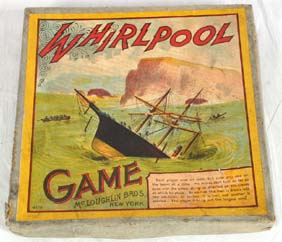
Thrift stores are just imagining things if they listen to people like Adele Meyer, executive director of the National Association of Resale and Thrift Shops, who said, “The reality is that all this stuff will be dumped in the landfill.” They should ignore all the reports, no matter how numerous and from how many sources, of local Goodwill operations and other thrift stores’ closing children’s departments or sweeping more than half their contents off the shelves, and of kids’ resellers and consignment shops taking massive financial hits or closing down entirely. All of these episodes are either imaginary or, if conceded as real, an instance of overreaction to the needless fears those moustache-twirling opponents have “fomented”. (Some more thrift-store coverage not previously linked: North Carolina, Nebraska, Minnesota with Goodwill pic, upstate New York (“We can’t be sure of the risk unless we take everything off the shelf”), South Dakota, Colorado). They should also stop predicting that the pursuit of their charitable missions will suffer a major blow from the loss of children’s resale revenue, because that sort of thing just undermines morale.
Handmade toy businesses are just imagining things if they listen to anyone like the Handmade Toy Alliance. It’s not as if anyone like them is on its list of members.
The Times editorialists warn against “needless fears” that the law “could injure” smaller enterprises. Got that? Not only will they not be driven out of business, they won’t even be “injured”. So small enterprises from coast to coast are just imagining things if they plead desperately for places like the Times to notice that they have already closed down, or will have to do so in the foreseeable future, or have lost thousands of dollars in unsalable inventories. Motorbike dealerships around the country are just imagining things if they think they’re staring at massive losses from the inability to sell their products, even though news-side talent at the New York Times has in fact covered their story well — coverage which the editorial studiously ignores.
For as long as anyone can remember, the New York Times has unthinkingly taken its line on supposed consumer-safety issues from organized groups like Public Citizen and Consumers Union. In this case, the result of such reliance has been to render the nation’s leading newspaper a laughingstock.
Public domain image: Grandma’s Graphics, Ruth Mary Hallock.
(& welcome Virginia Postrel, Christopher Fountain, Patrick @ Popehat, Carter Wood/ShopFloor, Mike Cernovich, Katherine Mangu-Ward/Reason “Hit and Run”, Jonathan Adler @ Volokh Conspiracy, Memeorandum, Above the Law, Tim Sandefur, Mark Thompson/Donklephant, Alison Morris/Publisher’s Weekly Shelftalker blog, Jacob Grier, Amy Alkon/Advice Goddess, Joe Weisenthal/ClusterStock, Valerie Jacobsen/Bookroom Blog readers. And: Deputy Headmistress at Common Room, Faith in Truth, Amy Ridenour/National Center and NewsBusters, Charles Kuffler/Off the Kuff.)
And more: Forbes.com liked this piece and has now reprinted it in slightly altered form. And I’m particularly grateful to Robert Ambrogi/Legal Blog Watch for his generous coverage.

